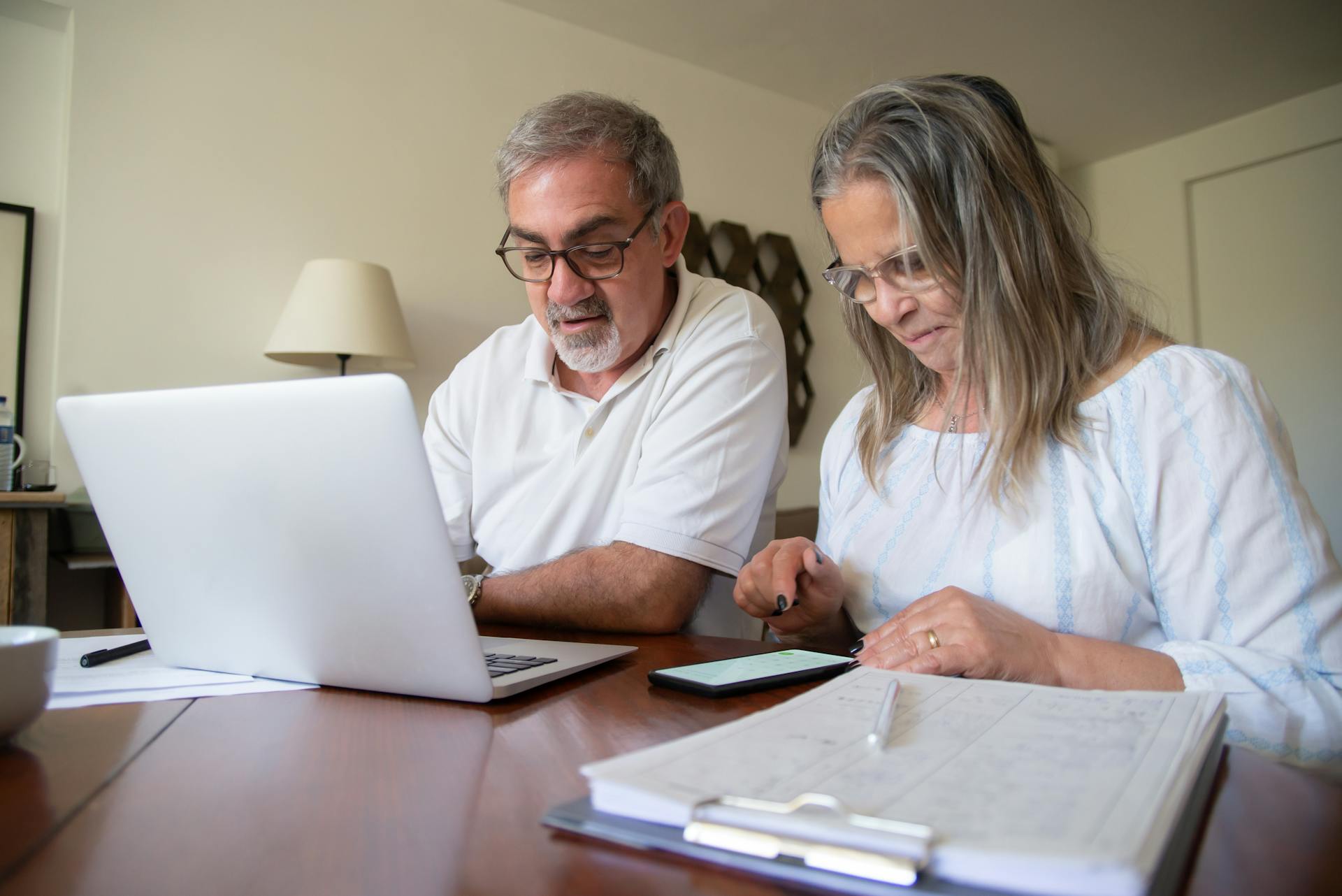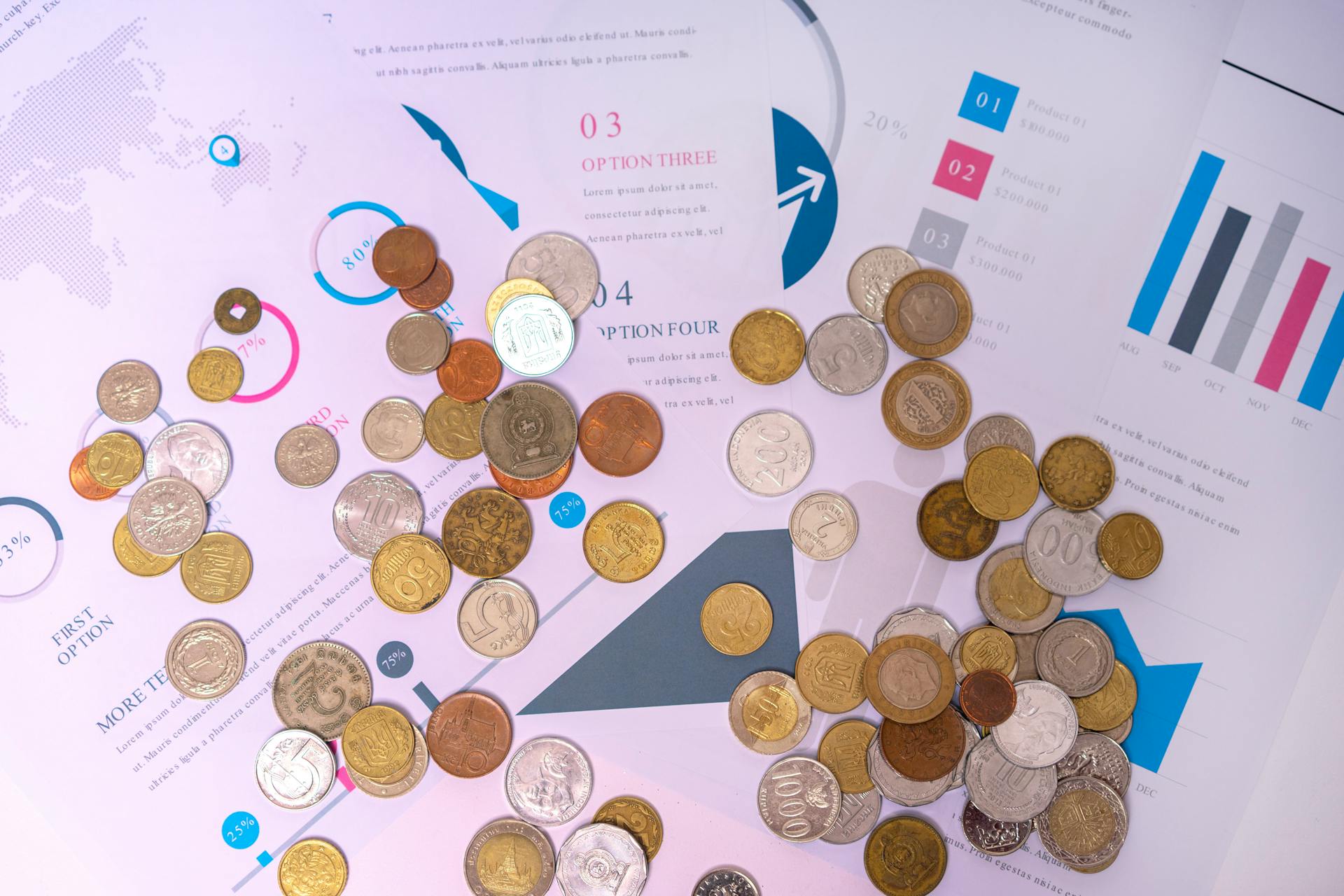
A reverse mortgage is a loan that allows homeowners to borrow money using the equity in their home as collateral. It's like tapping into the value you've built up in your home over the years.
The loan doesn't require monthly payments, which can be a big relief for seniors on a fixed income. However, the interest on the loan will still accrue, and the borrower must continue to pay property taxes and insurance.
Homeowners can choose to receive their loan proceeds as a lump sum, monthly payments, or a line of credit. It's essential to consider your financial situation and goals before deciding how to receive your funds.
Readers also liked: Title Loan Balloon Payments
Eligibility and Basics
To be eligible for a reverse mortgage, you must own your home and be at least 62 years old, although one spouse can be younger if the other is 62 or older. Your home must be your principal residence, which means you must live in it more than half the year.
You can have a reverse mortgage if you own a single-family property, a two- to four-unit building, or a federally approved condominium or planned-unit development (PUD). However, you cannot have a reverse mortgage on a cooperative apartment or a mobile home without a foundation that meets U.S. Department of Housing and Urban Development (HUD) guidelines.
If you have debt against your home, you must pay it off before getting a reverse mortgage or use an immediate cash advance from the reverse mortgage to pay it off. Lenders will not lend on homes with outstanding debt.
To qualify for a reverse mortgage, you'll need to pass a financial assessment, which will analyze your credit history, monthly income and expenses, and ability to pay property taxes and insurance.
Here are some key eligibility requirements:
- You must be at least 62 years old (or have a spouse who is 62 or older)
- Your home must be your principal residence
- Your home must be a single-family property, a two- to four-unit building, or a federally approved condominium or PUD
- You must have paid off any debt against your home or use a cash advance to pay it off
- You must pass a financial assessment
Remember, reverse mortgages are a type of loan, and you'll still be responsible for paying property taxes, insurance, and upkeep on your home.
How It Works

A reverse mortgage works by giving you a loan based on the value of your home equity. This loan is essentially a way for lenders to give you cash in exchange for the equity you've built up in your home.
You can think of it as a loan where the lender gives you money based on how much equity you have in the property. This equity is the difference between your home's appraised value and the amount you still owe on the mortgage.
Home equity is typically calculated by subtracting the mortgage balance from the home's value, so if you own a home worth $300,000 and owe $50,000, you have $250,000 in equity. This is a substantial portion of your net worth, and a reverse mortgage can help you tap into it.
You can receive fixed monthly payments or a line of credit based on the value of your home equity. This can be a great way to supplement your income in retirement, especially if you're not ready to sell your home.
Intriguing read: How Do I Know If I Have a Heloc Loan
Borrowing and Fees

You're borrowing money from your home's equity, which is a big deal. You're essentially tapping into the value of your home, and the lender will give you a percentage of that value based on your age, interest rates, and area.
You only pay interest on what you borrow, so if you don't use all the money, you won't be charged for it. This is a good thing, because it means you can keep some of your equity intact.
Here are some fees you can expect to pay: Payments to the originatorThe appraiserPostage feesRecording fees These fees are similar to the ones you paid when you first bought your home.
You'll also have to pay back the loan, with interest, when you no longer live in the house full-time. But don't worry, you'll never owe more than your home is worth.
Consider reading: Reverse Mortgage Fees
How Much Can I Borrow?
Your borrowing power increases with age, so an 80-year-old will be able to borrow more than a 62-year-old if all other factors are equal. This means that as you get older, you'll have more access to the equity in your home.
Broaden your view: 40 Year Mortgage Rates Today

The value of your home also plays a big role in determining how much you can borrow. If your home is more valuable and/or you have a higher amount of home equity, you'll be able to borrow more. This is because the lender can use the value of your home as collateral for the loan.
Interest rates also affect how much you can borrow. If interest rates fall, you'll be able to borrow more at a lower rate than at a higher rate. For example, you'll be able to borrow more at a 4% rate than at a 6% rate.
Here's a summary of the factors that affect how much you can borrow:
Mortgage Borrower Obligations
As a homeowner considering a reverse mortgage, it's essential to understand your obligations as a borrower. You must continue to use the home as your primary residence, which means you can't rent it out or move in with family members for extended periods.

To maintain the home, you'll need to do necessary repairs and stay on top of property taxes and homeowner's insurance premiums. If you fall behind on these responsibilities, you risk defaulting on the loan, which can lead to foreclosure.
The financial assessment added in 2014 makes it less likely for homeowners to default, but it's still crucial to stay on top of your obligations. A reverse mortgage is not a free pass to neglect your home or financial responsibilities.
Here are the key obligations you'll need to meet:
- The home must be your primary residence.
- You must maintain the home and do necessary repairs.
- You must stay current on property taxes and homeowner's insurance premiums.
By understanding and meeting these obligations, you can ensure a smooth experience with your reverse mortgage and maintain your home for years to come.
How Much and When?
The amount of cash you can get from a reverse mortgage depends on several factors, including your age, the value of your home, and current interest rates. Generally, the most cash is available for older borrowers living in homes of greatest value with low current debt.

The type of payment option you choose also affects how much cash you receive. If you select a program that pays you over a longer period, you'll likely receive less monthly than from a program that pays you for a fixed number of years. This is because longer payment periods result in smaller monthly payments.
You can choose among three main payment options: monthly, lump sum, or a combination of both. The monthly option is the most commonly selected, as it provides a steady income stream. However, not all monthly payment options are created equal, and some programs commit to a particular payment for a preset number of years.
The lump-sum option is generally the least beneficial, but it can make sense if you have an immediate need for a substantial amount of cash, such as making a major purchase or paying off existing debt.
Here are the three main payment options and their characteristics:
- Monthly payments: Most common option, provides a steady income stream, but may have varying payment amounts.
- Lump sum: Generally the least beneficial, but can be useful for immediate cash needs.
- Combination: Some lenders allow you to mix and match payment options, but not all programs offer this flexibility.
Withdrawal and Benefits

With a reverse mortgage, you have several options for withdrawing your money. You can withdraw a lump sum of cash when the loan closes, receive a monthly annuity for as long as you live in the house, or take out a line of credit that grows over time.
You can also combine multiple options into a plan that suits your needs. For example, you could take out a certain amount of cash at closing while also receiving an annuity. This flexibility is one of the best features of the HECM program.
Here are the four basic options for withdrawing your money:
- Withdraw a lump sum of cash when the loan closes.
- Receive a monthly annuity for as long as you live in the house.
- Receive a monthly annuity for a set period of time chosen by you.
- Take out a line of credit that can be used at your discretion.
You can also switch from one option to another over time, although you may need to pay a small fee.
Options for Withdrawal
When obtaining a reverse mortgage, you have the flexibility to choose how you receive the proceeds. You can withdraw a lump sum of cash at loan closing.
One of the most popular options is the monthly annuity, which can be paid for as long as you live in the house, known as a "tenure" annuity. This can provide a steady stream of income.
For another approach, see: Reverse Annuity Mortgage

You can also choose to receive a monthly annuity for a set period of time, called a "term" annuity. This can be helpful if you have a specific financial goal in mind.
If you prefer to have more control over your funds, you can take out a line of credit that grows over time. This credit line can be used at your discretion.
You can also combine multiple options to create a plan that suits your needs. For example, you could take out a certain amount of cash at closing while also receiving an annuity.
For your interest: Hecm Line of Credit
Key Benefits
The amount of your reverse mortgage is based on how old you are, how much your home is worth, and what interest rate the lenders offers to you. Generally speaking, the older you are and the more your home is worth the more you’ll receive.
You can have the money disbursed to you in the form of a check or a line of credit. Lump sum payments are also popular.
In 2011, 73% of borrowers chose a lump sum payment. This shows just how appealing this option can be.
With a reverse mortgage there is no loan to repay as long as you are alive, living in the home, and keeping the terms of your loan.
Government and Regulations

The government has a lot to say about reverse mortgages, so let's break it down.
The Federal Housing Administration (FHA) is the main regulator of reverse mortgages, and it's been around since 1934.
The FHA's reverse mortgage program is called Home Equity Conversion Mortgage (HECM), and it's been available since 1989.
To qualify for a HECM, you must be at least 62 years old, own your home, and have a significant amount of equity in it.
The HECM is insured by the FHA, which means it's backed by the government in case you default on the loan.
The government also sets limits on the amount of money you can borrow with a HECM, which is currently $726,525.
Reverse mortgage lenders must also follow strict guidelines set by the Department of Housing and Urban Development (HUD) to ensure borrowers are treated fairly.
These regulations are in place to protect you from predatory lending practices and ensure you understand the terms of your loan.
As of 2020, the HECM program has undergone several changes to make it more borrower-friendly and to reduce the risk of foreclosure.
The government also requires lenders to provide counseling to borrowers before they take out a reverse mortgage, to ensure they understand the loan's terms and potential risks.
Suggestion: Gov Refi Program
Understanding Mortgages

A reverse mortgage is a way to tap into the equity in your home without selling it. You can think of your home as the Bank of You, borrowing money that you would have earned if you sold your house.
To qualify for a reverse mortgage, you need to be at least 62 years old and own your home with little or no mortgage debt. A reverse mortgage lender will determine how much they can lend you based on your home's value, age, and interest rates.
You still own your home and can continue to live in it, but now you're getting payments from the lender, solving your cash flow problem. You pay the loan back (with interest) only when you don't live in the house full-time anymore, usually due to moving out or death.
A reverse mortgage is sometimes called a deferred payment loan because you're not paying off the home loan as you borrow money. Instead, the payments are put off (deferred), which is why reverse mortgages can be a good choice for seniors on a fixed income.
A different take: Will Lender Accept If a Friend Gift Money Conventional Loan

You don't owe more than your home is worth, no matter how much debt you accumulate. If you owe the lender $67,000 and your home sells for $200,000, you keep the difference.
Here are some key things to know about reverse mortgages:
- You're a homeowner who owes little or nothing on your home.
- A reverse mortgage lender figures out how much it can lend you based on your home value, age, and interest rates.
- You still own your home and continue to live in it.
- You pay the loan back (with interest) only when you don't live in the house full-time anymore.
- You never owe more than your home is worth.
- You keep any leftover equity after the sale of the house.
A reverse mortgage is not free money, though. There are fees involved, including payments to the originator, appraiser, and other costs. You also pay interest on your loan, which is generally around the interest rates on traditional mortgages.
Financial Impact
A reverse mortgage can be a game-changer for seniors, but it's essential to understand its financial impact.
For seniors with a fixed income in retirement, a reverse mortgage can supplement their income to cover living expenses. This can be a huge relief, especially for those who are struggling to make ends meet.
The Consumer Finance Protection Bureau's report found that seniors who will remain in their home for a long time horizon can benefit from a reverse mortgage. This is because the loan doesn't require monthly payments, which means you can keep your home without worrying about making mortgage payments.
On a similar theme: Do You Pay Interest on a Reverse Mortgage

Seniors who need a home equity line of credit (HELOC) but can't qualify can also use a reverse mortgage to access funds. This can be a lifesaver in case of unexpected expenses or emergencies.
Here are some ways a reverse mortgage can be used to eliminate monthly payments:
- Pay off a forward mortgage and eliminate the monthly payment that goes with it.
- Use a credit line to pay unexpected expenses, protect against loss of income from the death of a spouse, and/or to make sure that retirement income remains stable even if your other sources of funds fluctuate.
By using a reverse mortgage, seniors can create a stable financial foundation for their retirement years.
Mortgage Details
A reverse mortgage is a way to tap into the equity in your home without selling it. You can think of your home as the Bank of You, where you borrow money that you would have earned if you'd sold your house.
You still own your home and continue to live in it, but now you're getting payments from the lender, so your cash flow problem is solved.
Here are the key details to understand:
- You're a homeowner who owes little or nothing on your home.
- A reverse mortgage lender figures out how much it can lend you based on your home value, your age, and interest rates.
- You pay the loan back (with interest) only when you don't live in the house full time anymore, usually due to moving out or death.
- You never owe more than your home is worth, no matter how much you've accumulated in debt.
- You keep any leftover equity after the sale of the house.
The payments are put off (deferred), which is why reverse mortgages can be such a good choice for seniors; when you're on a fixed income or living off of your savings, it can help to have some extra cash in hand to supplement.
Frequently Asked Questions
What is the downside of a reverse mortgage?
A reverse mortgage can reduce your home's value and limit future borrowing power, as the loan balance grows over time. Additionally, high upfront fees are often required.
What is the 60% rule in reverse mortgage?
The 60% rule in reverse mortgage limits the amount borrowed to the greater of 60% of the home's equity or 110% of mandatory obligations. This rule helps ensure borrowers don't over-borrow against their home's value.
What does Suze Orman say about reverse mortgages?
Suze Orman warns that reverse mortgages can be expensive due to various fees. She advises caution when considering these loans, which come with origination fees, mortgage insurance premiums, and closing costs.
What is the 95% rule on a reverse mortgage?
To qualify, heirs must sell the home for at least 95% of its appraised value, with the remaining balance covered by mortgage insurance. This rule ensures heirs don't inherit a significant debt.
Who really benefits from a reverse mortgage?
Homeowners aged 62 or older can benefit from a reverse mortgage, which can provide tax-free income to help with living expenses and stay in their home. However, it's essential to understand the borrowing costs and responsibilities involved.
Sources
- https://reversemortgagealert.org/introduction/
- https://www.abebooks.com/9780764584466/Reverse-Mortgages-Dummies-Lyons-Sarah-0764584464/plp
- https://www.dummies.com/article/business-careers-money/personal-finance/loans-credit/mortgages/understand-reverse-mortgages-153287/
- https://www.dummies.com/article/business-careers-money/personal-finance/loans-credit/mortgages/reverse-mortgages-for-dummies-cheat-sheet-207693/
- https://www.dummies.com/article/reverse-mortgage-work-251551
Featured Images: pexels.com


